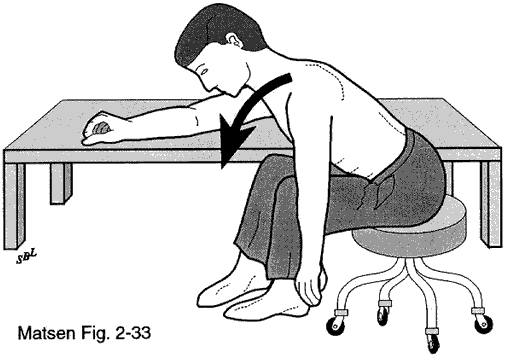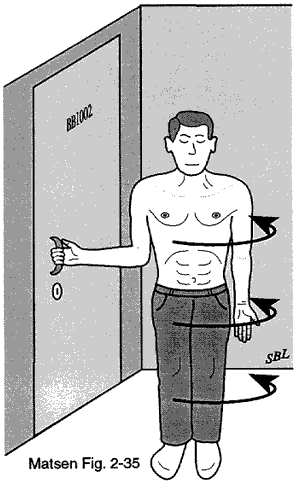Stiff or frozen shoulders are usually uncomfortable, even if the degree of stiffness is not great. That's the bad news. The good news is that most stiff shoulders can be managed successfully by a simple exercise program conducted by the patient in the home.
Getting the shoulder moving
It is basically a question of gently and progressively getting the shoulder moving again. This program is the safest of all treatments for frozen shoulders. Although months of these specific exercises may be required, persistence almost always pays off. Even if arthritis is present, this program may help preserve and even improve the shoulder's range and comfort. Before beginning these exercises you should consult with your physician.
There are two components to the home program for stiff shoulders. The first is a series of stretching exercises and the second relates to regular participation in a fitness program.
Your opposite arm is a great therapist for your stiff shoulder. Your "therapist arm" is always available to apply a gentle stretch in any direction of tightness. Each of these gentle stretches needs to be held up to a count of 100.
Stretching Exercises for the Frozen or Stiff Shoulder
Photo Gallery
The basic program includes the exercises illustrated below. Click any image below to enlarge and view in our photo gallery.






Videos
The box below includes a playlist of videos of all the exercises depicted in the illustrations above. Watch the videos below or on our youtube channel.
Instructions for Shoulder Stretching Exercises
If other directions of stiffness are identified, they can be stretched with a similar approach. An important principle of the stretching exercises is to allow your muscles to relax so that the stretch can be applied to the soft tissues without muscle interference. Tissues of a tight shoulder do not like to be stretched suddenly, roughly, or with a lot of force. Thus the strategy is to apply a gentle stretch so that at most minimal soreness results. Any soreness should go away within 15 minutes after you stop the exercises.
You should carry out this shoulder stretching sequence three times a day. As much as possible, these sessions should be performed after the shoulder has been relaxed by a hot shower, bath, or aerobic exercise. For each stretch, make a note of the maximum range obtained with each session. Try to establish a new "bench mark" each time you do them, so that you can see your progress each time.
The beauty of this exercise program is that you are in control. You can adjust the vigor of the stretching to do what is most easily tolerated by your shoulder. The exercise program is totally portable and can be performed in your home, office, car, the bus, the airplane, or wherever you happen to be. This is important because consistency in this exercise program pays off. If pain results from the exercise program, do not stop or change the frequency of your exercise sessions, just reduce the vigor of the stretches so that they become comfortable.
Regular fitness exercise helps keep your joints supple. This "lubricating" effect is optimized if you perform a half-hour of aerobic exercise each day.
Many types of fitness exercise
This exercise may take a variety of forms including brisk walking, jogging, riding a stationary or mobile bicycle, rowing, climbing stairs, or using a cross-country skiing simulator. If you have concerns about your ability to carry out such an exercise program, you should consult your general physician. It is not important that these exercises be carried out vigorously, it is only important that in addition to the stretching program, a half an hour of your day be devoted toward some form of aerobic exercise. A guideline for someone with a healthy heart, lungs and blood pressure is to work up to 30 minutes of exercise at a target of two-thirds of his or her maximum heart rate. Your maximum heart rate is estimated by subtracting your age from 220. If you are over 35 and have not been exercising much, or if you are not sure of your health, you should consult your doctor before starting this aspect of the program.
Many patients are reluctant to try this stretching and aerobic program because they have already "had therapy." Our repeated observation is that many patients who have not responded to formal therapy sessions can improve their shoulder function using this home program. Remember that your shoulder stiffness has been present for quite a while. Improvement in your range of motion and comfort may not begin until six weeks of persistence with the program. You should not stop these exercises until your shoulder has regained normal motion and comfort.
We have found that medication is not very helpful in managing stiff shoulders. Mild analgesics (such as aspirin, ibuprofen, or acetaminophen) may be used in conjunction with this program if desired. Narcotic medications, "muscle relaxants" and sleeping pills have not proved helpful to our patients.
You may be able to use the shoulder actively within the range of comfort. For example, if you can do some water exercises or swimming without aggravating the shoulder, please do so. On the other hand, activities which produce shoulder pain should be avoided.
If you have any questions about your shoulder or the proper treatment, let your doctor know.
Additional Information
See: The Shoulder Arthritis Book at
http://shoulderarthritis.blogspot.com/2011/03/what-is-difference-between-shoulder.html
See: The Rotator Cuff Tear Book at
http://shoulderarthritis.blogspot.com/2013/12/the-rotator-cuff-tear-book.html
http://shoulderarthritis.blogspot.com/2011/03/what-is-difference-between-shoulder.html Shoulder arthritis and frozen shoulder - what's the difference?
http://shoulderarthritis.blogspot.com/2011/03/exercises-for-arthritic-shoulder.html - Shoulder exercises